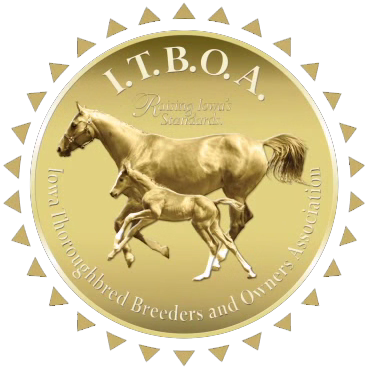In 1996 Otto concluded the Iowa horse population was 843. In 1999 that number has grown to 12,500 and the total number of horse owners in Iowa now stands at over 1500.
Iowa Thoroughbred Foal Production
When pari-mutual wagering was approved in 1989, Iowa was producing around 250 thoroughbred foals per year. When Prairie Meadows filed for bankruptcy, foal production dropped 25 percent. Many breeders and owners sold out and closed down their farms. When slot machines were approved for the tracktrack, the breeding industry rebounded almost overnight and began a long period of steady growth. By 2001, Iowa was considered the fasted growing Thoroughbred breeding state in the country.
In the fall of 2001, it was announced that purses for 2003 would be slashed 25 perscent from 2002 levels. The purse cuts created an uncertainty in the minds of many breeders and owners about the future of racing in Iowa. Some breeders reduced their breeding stock, while others moved their broodmares to neighboring states. In 2003, the number of throughbred foals born in Iowa dropped to levels not seen since the mid 1990’s/
In 2004, legislative protection for purses retured some of that stability to the industry and foal production is now growing again.
Expenditures by Iowa Horse Owners
The study also shows the expenditures made by Iowa horse owners have raised dramatically. Those expenditures include everything from hay and feed to taxes, insurance, advertising, and transportation. Otto conlcuded that total expendatures exceed $97 million dollars a year compared to $40 million in 1995. Those dollars are pumped directly into the Iowa economy every year. when you consider that purses paid at Prairie Meadows in 1999 were only $13 million, that is a tremendous impact.
The Benefit to Polk County Today
Polk County already reaps a huge economic impact from live racing at Prairie Meadows. A survey of horse trainers and owners this past summer shows the average cost of keeping a horse in training at the track is $1,500 per month. Many of our members say that figure is conservative. At $1,500 per horse times 1350 horses, you’re talking about $2 million a month or $10 million during the course of the racing season. That money is pumped directly into the Polk County economy in the form of wages to stable help, sales to feed and hay vendors, income to farriers and veterinarians. Those people all have to live in Polk County while they are here and buy food, clothing, gas, etc. This doesn’t include the direct economic impact of tourism tied to live racing which Otto estimates to be over $5 million a year.
Iowa Compared to Other States
According to The Jockey Club which oversees the registration of Thoroughbreds nationwide, Iowa is the fastest growing breeding state in the country (1999 figures). Iowa now ranks 12th nationally in the number of foals produced annually. In 1995 Iowa was not even in the top 20.
The quality of Iowa Breds has also improved dramatical. This year Iowa Breds competed at more than 25 racetracks around the country and won races at prestigious tracks like Keeneland, Churchill Downs, Oaklawn Park, Remington Park, Hawthorne Race Course and Arlington Park. These horses are winning money out of state and bringing those profits back to their Iowa owners and the Iowa economy. Iowa thoroughbreds have become a valuable export commodity.


